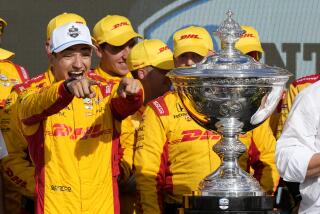He Was an Under-a-Cheever Until Now
- Share via
ORLANDO, Fla. — For 19 years, Eddie Cheever has been chasing the checkered flag--eight in Formula One and 11 in Indy cars--without a win in the major leagues. On a number of occasions he probably should have been in victory circle, like the time he ran out of fuel with two laps to go while leading at Nazareth, Pa.
Saturday, in the Indy Racing League’s rain-shortened Indy 200 on a three-cornered oval at Walt Disney World Speedway, he finally won one--one that he probably should not have won. And he did it in his new role as owner-driver of FirstPlus Team Cheever.
Cheever, 39, who had never before even led a lap in an IRL event, was more than a lap behind when leader Buzz Calkins dropped out because of a smoking engine on Lap 144 and Tony Stewart spun in his own oil and hit the wall two laps later.
This left Cheever in front; two laps later rain caused the race to be halted on the 149th lap.
“I’m very happy,” Cheever said as he climbed out of his G Force/Oldsmobile Aurora. “I feel sorry for the fans [an estimated 42,000], but not the way the race came to us.”
Until Stewart’s G Force/Olds Aurora broke an oil line, dousing the right rear wheel with oil that sent the car skidding into the outside wall, the precocious pole-sitter had led 131 laps and at one point had lapped the field. He seemed in complete control, passing lapped cars on the inside, the outside or slicing between them.
“We crashed, that’s all I can say,” said a dejected Stewart, 25, who has led all six IRL races but has yet to win one. “We learned to lead laps but not the right ones. We had an oil leak that dumped oil on the right rear tire. The same thing happened to us in testing.”
It wasn’t much consolation, but Stewart and Team Menard received $10,000 for leading the most laps. Prize money will not be announced until later this week, but Cheever is expected to collect about $200,000.
For the IRL, the unveiling of its all-new chassis and engine combinations that will be the look of the Indianapolis 500, proved to be mildly satisfying. Nine of the 19 starters were still running and there were no serious accidents to damage the short-handed equipment.
“I started the race extremely conservatively because no one really knew what to expect,” Cheever said. “I have increased respect for the mechanics and all the work they do, now that I am the owner too. I am very proud of the team we have put together.”
Second was Mike Groff, in one of three cars powered by late-arriving Nissan Infiniti engines.
“Nissan just did a fantastic job with an engine that was only 17 days old,” Groff said. “And very few of those 17 days was the engine actually running in the car. The circumstances [finishing second] weren’t to our liking, but we’ll take it.”
Although this was the IRL’s first race with its new look in equipment, it was the third of the 1996-97 season that included races last year in New Hampshire and Las Vegas. Groff leads with 96 points to 86 for Calkins and 85 for Scott Sharp, who won at New Hampshire.
Scott Goodyear finished third in another G Force/Olds Aurora, but the next six finishers were in Dallaras, the other new chassis.
“Tony George and the IRL really rocked the boat with this series,” Cheever said. “It is my opinion that people just don’t like change, but this is one change for the better. Everyone here was restricted by time, getting all new engines and chassis together, but by the time we get to Phoenix [March 23] we should have a full field and I wouldn’t be surprised if there were 40 or 50 cars at Indianapolis.”
Cheever became the first owner-driver to win an Indy car race since 1981, when A.J. Foyt won the Pocono 500. Although this was his first in F1 or Indy cars, Cheever did win a sports car endurance race at the Spa, in Belgium, in 1986.
Other than Stewart’s oil-slick crash, the only accident occurred when rookie Jeret Schroeder spun and hit the wall on Lap 93 and Arie Luyendyk, running in second place, slid through the grass in an attempt to avoid him.
“When Schroeder spun, the guys in front of me slowed down dramatically,” said Luyendyk, the 1990 Indy 500 winner. “I couldn’t slow down without hitting the wall, so I went to the left and ended up spinning out. I had problems with traffic.”
Lapped cars were a source of complaint by others too.
“I was having problems with Marco Greco all day,” Cheever said. “He was driving me crazy. There are some poorly educated drivers who hold you up, but it happens in every series.”
“There are guys who were two and three laps down,” Stewart said. “They’d go from the outside wall down to the grass before they got out of the second turn. There is no reason to make a chicane out of a straightaway.”
More to Read
Go beyond the scoreboard
Get the latest on L.A.'s teams in the daily Sports Report newsletter.
You may occasionally receive promotional content from the Los Angeles Times.










